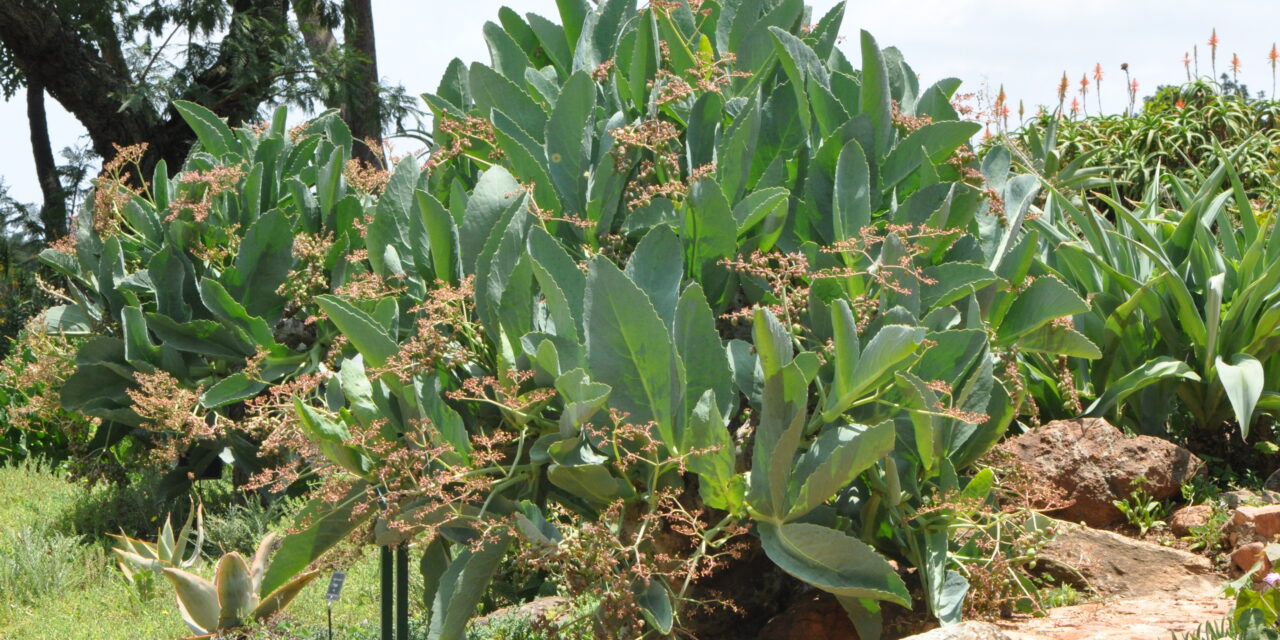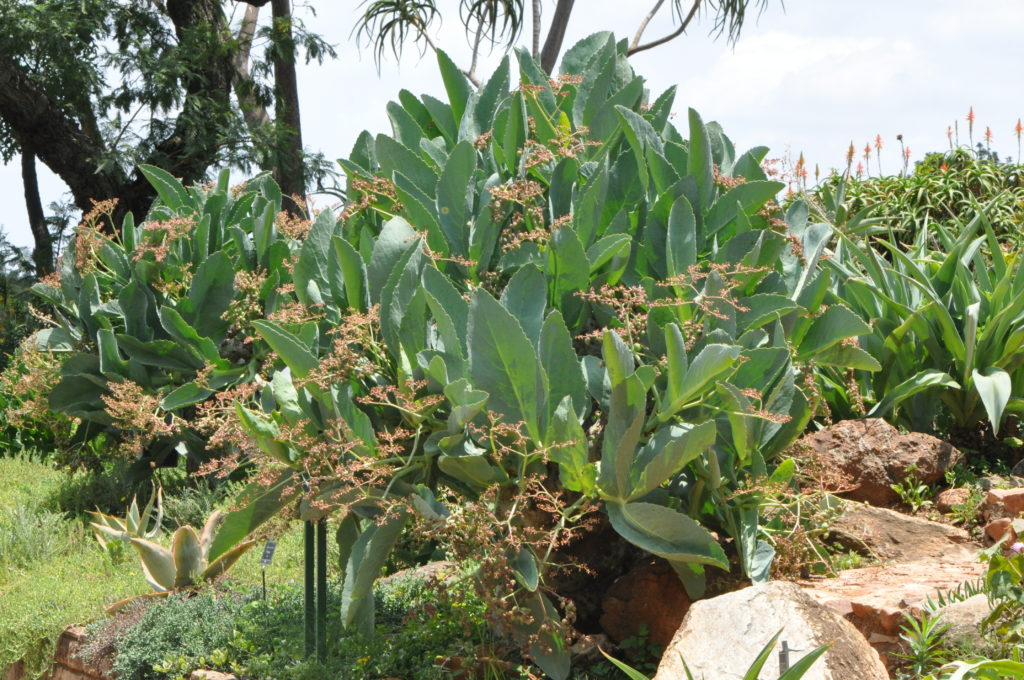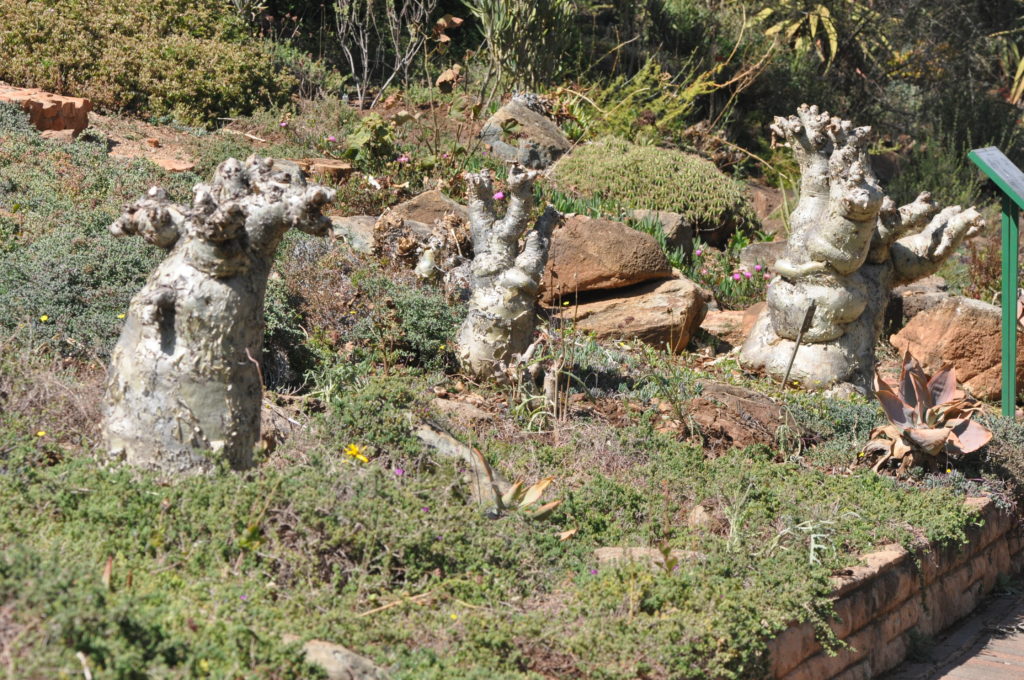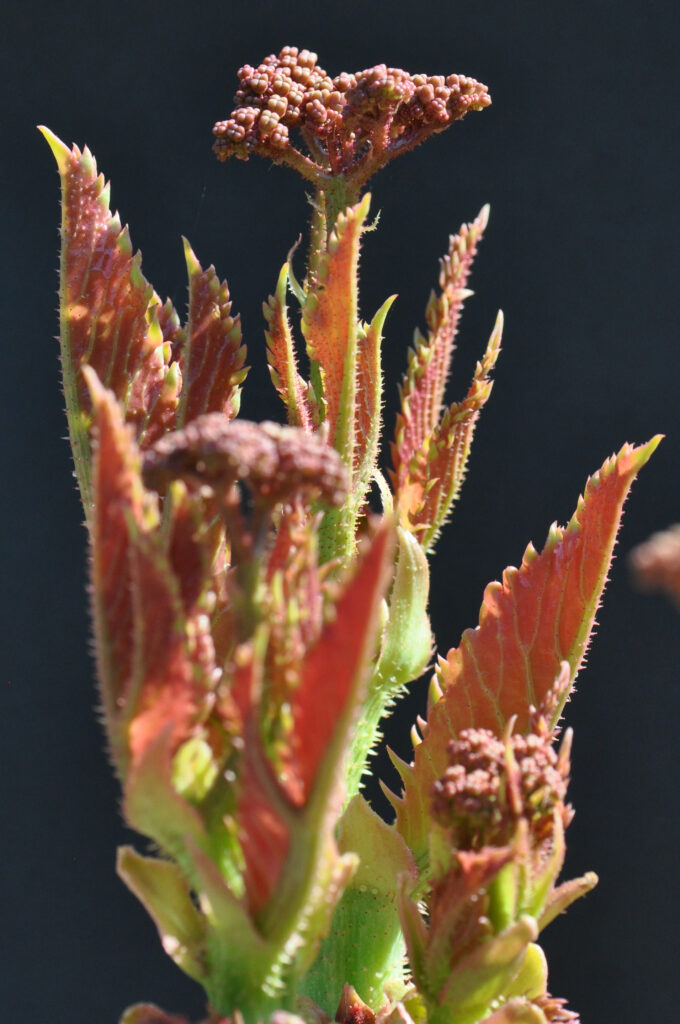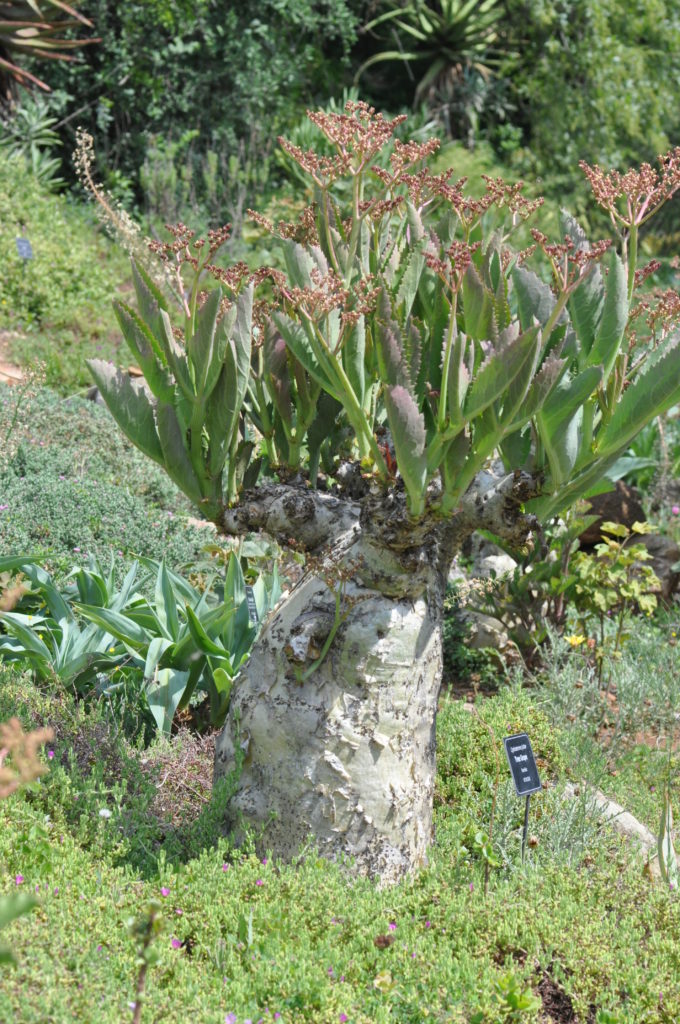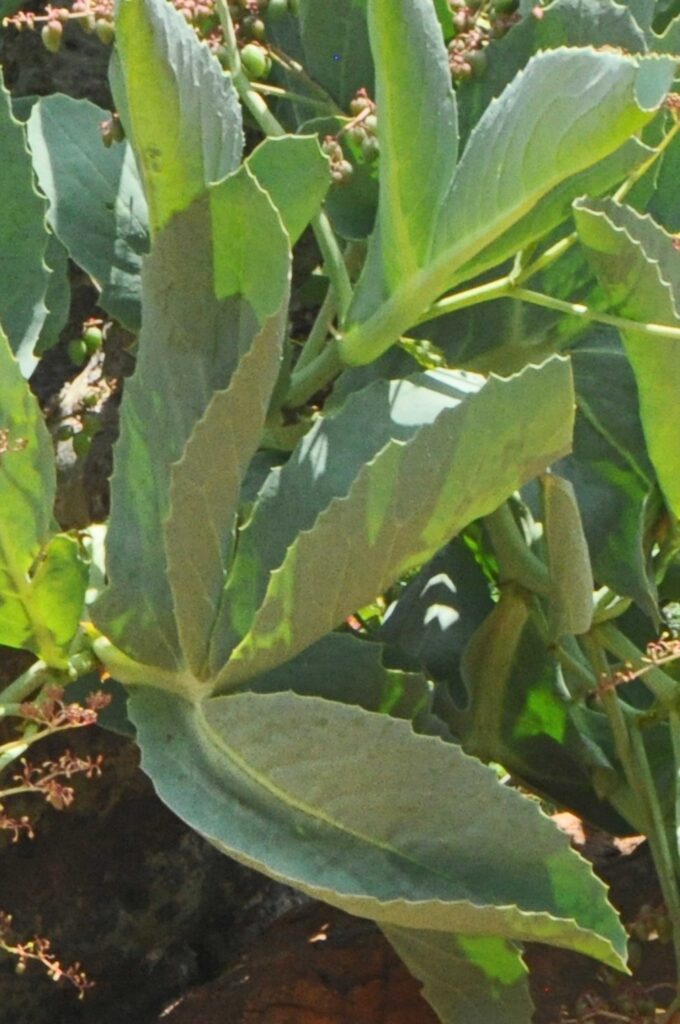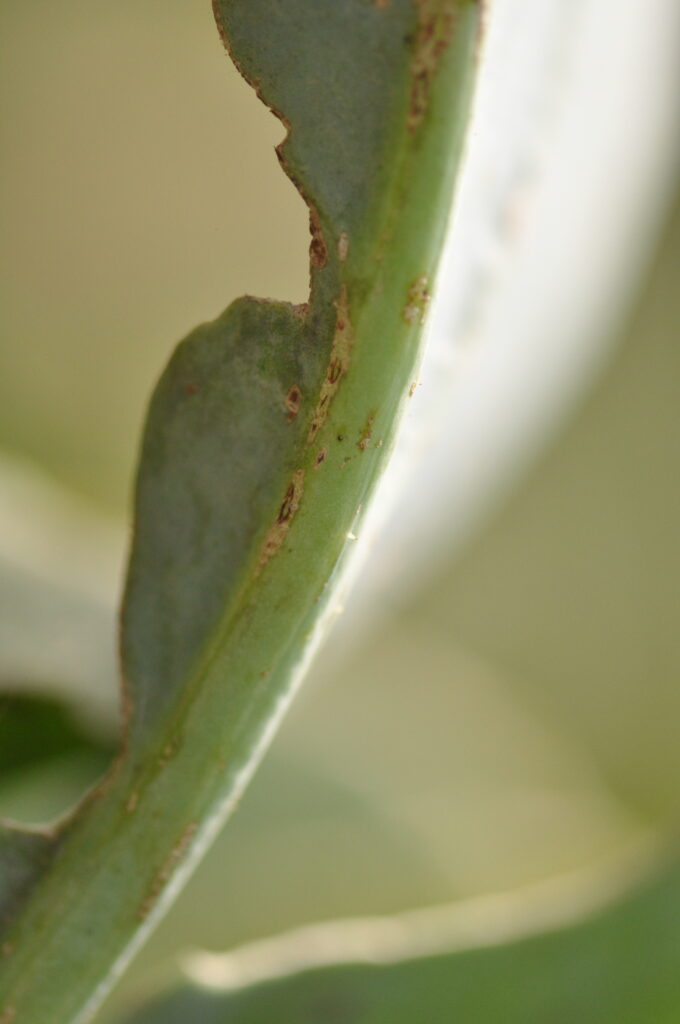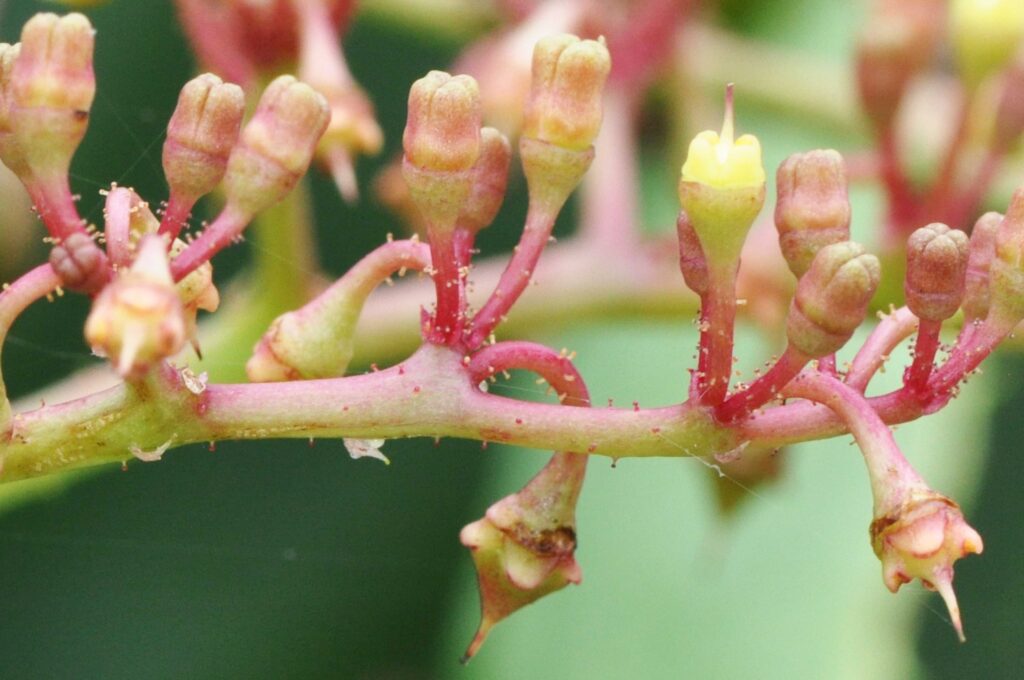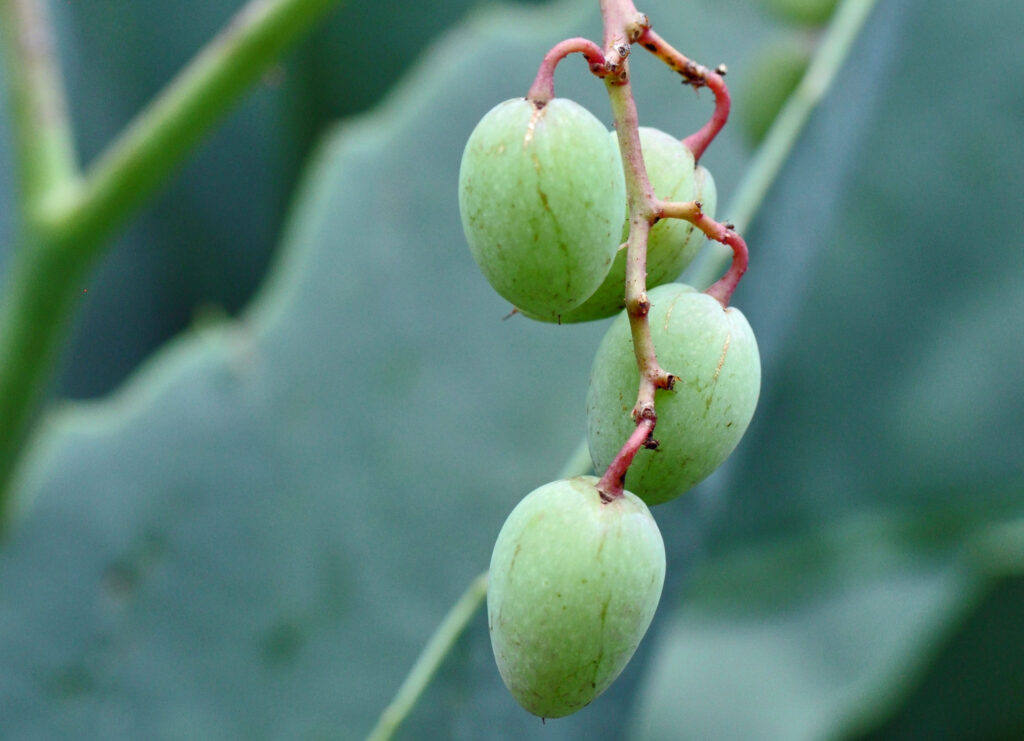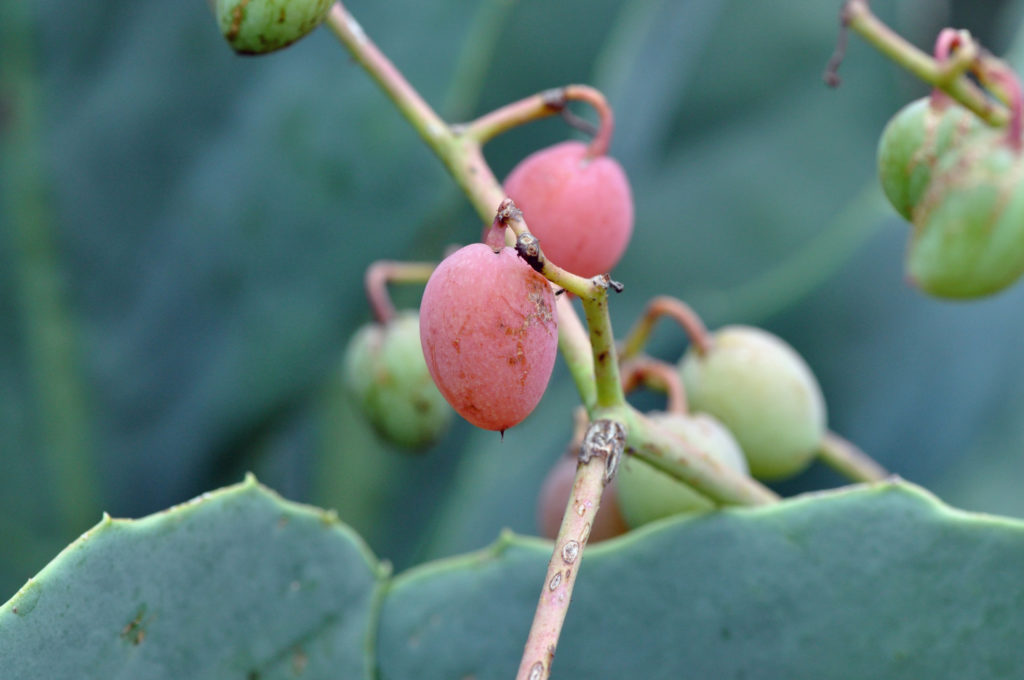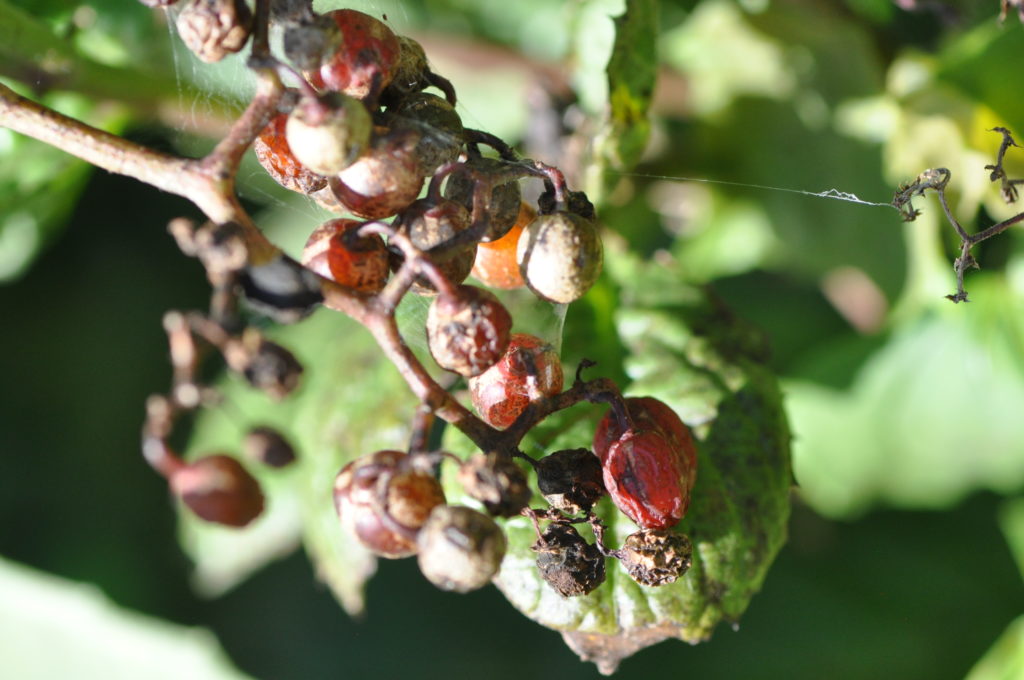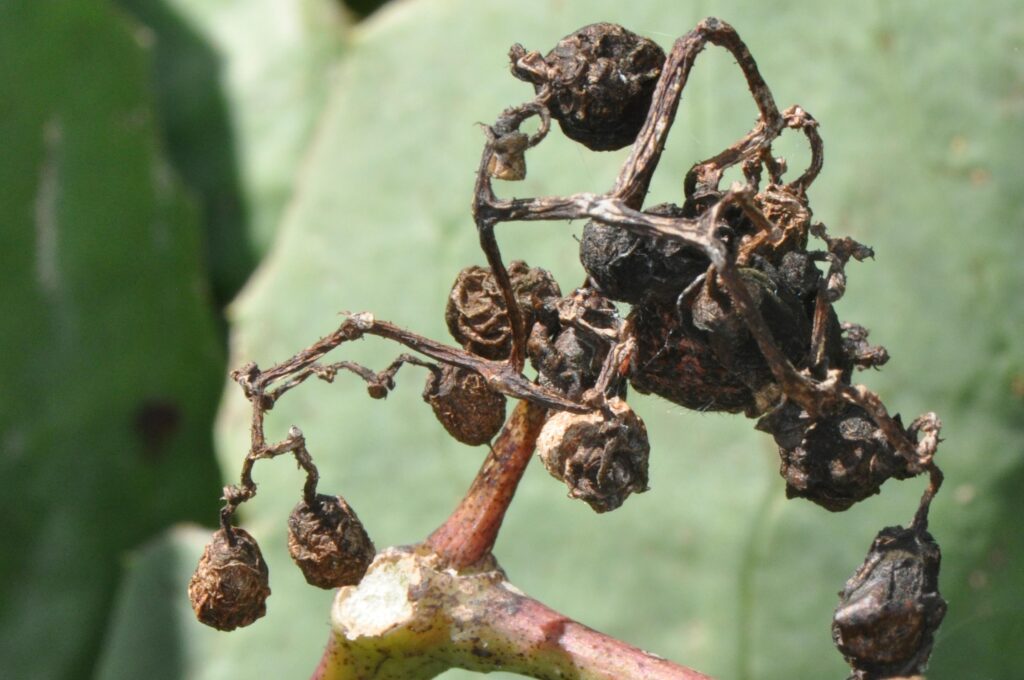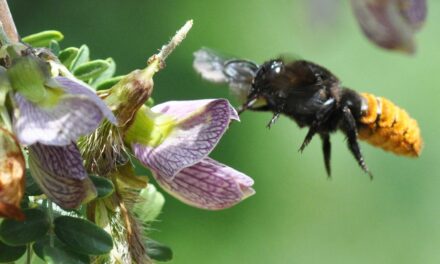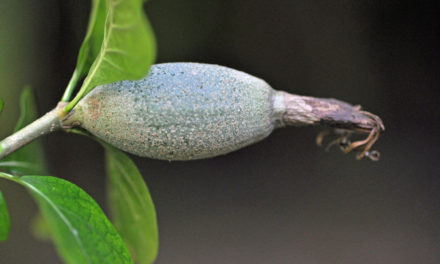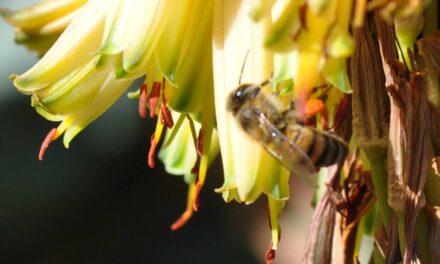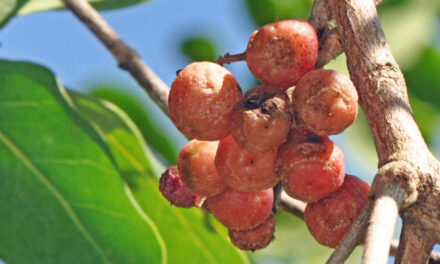Cyphostemma juttae
General Info – summary
This slow growing, succulent & pachycaul Tree lacks tentacles & may reach 5m high – usually 2m. Smooth bark is shiny, and branches are short and stubby. The simple, blue-green Leaves become trifoliate and very large. Wing-like margins run down petiolules. The bisexual, regular, 4-merous and greenish cream Flowers develop in cymes. The ovary is superior. Ripe Fruit is a black shrunken grape-like berry.
Description
Previous Names: Cissus juttae
SA Tree No. 456.1.
Common names: (Afr) Botterboom, Bloukobas, Jutta’s Botterboom. (Eng) Blue Cobas, Elephant’s Foot, Namibian Grape, Tree grape, Wild grape.
Family Vitaceae (Grape Vine Family) with has about 14 genera and in excess of 900 species worldwide. The plants are herbaceous or woody and often climbing with tendrils. Leaves are alternate and leaf nodes are swollen. The actinomorphic (regular; symmetric) Flowers are usually bisexual and in cymes – opposite the leaves. The Corolla has 4-6 petals. Opposite the petals are 4-6 Stamens. The free Filaments are attached to the centre of the Anthers and each anther has 2 pollen sacs which dehisce lengthwise. The superior Ovary has 2 ovules in each of its 2 locules and extends via a short style. The Fruit is a berry containing up to 4 seeds. Examples on this website include 2 species of the genus Cyphostemma.
Name derivation: Cyphostemma – curved or humped crown. juttae: named after Jutta Dinter, the wife and tireless companion of Moritz Kurt Dinter (1868-1945). He was a German botanist and explorer in Namibia (South West Africa). He landed at Swakopmund in June of 1897 and was appointed botanist of the then South West Africa. There are 34 species of the genus Cyphostemma in southern Africa.
Conservation Status: The IUCN Red List of Threatened Species: L C. (Least Concern). However, it was noted that the population should be monitored. Date 2004/04/30.
Tree
The Tree is a pachycaul (having a disproportionately thickset, swollen trunk for its height (photo 204). This feature also occurs in the baobab Adansonia digitata and Adenia fruticosa). Cyphostemma juttae is a dwarf succulent and a slow growing tree. It may reach 5m or more but is usually less than 2m high (photo 204). The trunk is relatively wide – up to 1m and almost round and looks obese – especially in winter when leaves have fallen (photo 204). Branches are short, smooth and stubby (photo 204). The shiny light green Bark becomes noticeable when the creamy coloured, papery outer layer peels off in flakes (photo 731 under Leaves). Unlike many other plants in this family, Cyphostemma juttae has no tentacles and is not a climber.
- 705. 2014/12/23. Walter Sisulu NBG. Photo: David Becking.
- 204. 2014/08/26. Walter Sisulu NBG. Photo: David Becking.
Leaves
This tree is deciduous (photo 204 under Tree) but a lack of water may also cause leaf loss at any time. The alternate, blue-green, thickened, shiny and fleshy Leaves are often simple and deeply lobed when young but become very large and trifoliate (compound leaf with 3 leaflets) when mature (photo 705R). Here the central Leaflet is the largest and is broadly elliptic to ovate and up to 35 x 15cm. Very young leaves are red (photo 412). Along the under surface of the leaves the Midrib has small spines. The Apex is tapering to rounded or sharply pointed (photo 412). The Base of the terminal leaflet is symmetric but asymmetric in the lateral leaflets. The Margins are coarsely toothed (photo 705R & 412). Leaflet margins run down into the Petiolules (stalks of leaflets), which become conspicuously winged in the process (photo 1002). The Petiole (leaf stalk) is short. The narrow lanceolate Stipules (basal appendages of the petiole) are initially conspicuous but fall early.
- 412. 2014/10/28. Walter Sisulu NBG. Photo: David Becking.
- 731. 2014/11/18. Walter Sisulu NBG. Photo: David Becking.
- 705. 2014/12/23. Walter Sisulu NBG. Photo: David Becking.
- 1002. 2104.04.01. Walter Sisulu NBG. Photo: David Becking.
Flowers
The small, bisexual and greenish cream Flowers are actinomorphic (Regular, symmetrical. Flowers are vertically divisible into similar halves by more than 1 plane passing through the axis). The flowers, which initially extend above the trunk (photo 731 under leaves), develop in cymes (broad: almost flat-topped cluster of flowers with the central ones opening first. The 4-merous flowers (photo 257RR) develop opposite the leaves. The cylindrical Buds are constricted near the central area and have a rounded apex. The Corolla has 4 yellowish Petals, which are initially hooded at the apex but are soon shed. There is a Disc (a more or less fleshy or elevated development of the receptacle) present. It contains 4 fleshy glands. There are 4 opposite Stamens with straight Filaments. The Anthers are attached by their centre and dehisce longitudinally. Two incompletely separated Locules, each with 2 Ovules are contained within the single superior Ovary. Protruding beyond the rest of the flower is simple slender Style, which tapers to a point (photo 257RR). In this photo, the bending down of the post fertilization flowers is visible. The broad, red Peduncle (stalk of a cluster of flowers) is armed with small prickles (photo photo 257RR). Flowering may depend on the rain (Nov-Feb). As expected, those planted in the USA (northern hemisphere) flower in June-July.
- 257RR. 2014/02/14. Walter Sisulu NBG. Photo: David Becking.
Fruit
The impressive, ovoid to almost spherical Fruit is a Berry (pulpy, indehiscent fruit like a grape or tomato – photo 261) and is up to about 12 x 7mm. After pollination, the developing fruit hangs down (photo 250). At this stage, the remains of the styles are clearly visible (photo 257RR under flower). Fruit is initially green (photo 259) but turns light red (photo 261). Finally, the purplish-black fruit shrinks when mature and become raisin-like (photos 926 & 924). Usually only a single Seed develops in each berry. (Dec-Jan+).
- 259. 2014/02/04.Walter Sisulu NBG. Photo: David Becking.
- 261 2014/02/04. Walter Sisulu NBG. Photo: David Becking.
- 926. 2014/03/25. Walter Sisulu NBG. Photo: David Becking.
- 924. 2014/03/25. Walter Sisulu NBG. Photo: David Becking.
Distribution & Ecology
The wide Trunk enables moisture storing that allows the trees to survive in desert (low summer rainfall) regions of central and northern Namibia as well as northwards. This is a slow growing plant. Although the leaves are large, they are also thick and this helps in water retention as does the light shiny bark, which reflects the sun (photo 204 – under Trees). Three other species of Cyphostemma occur north of Walvis Bay.
Ethnobotany
The fruits may, or may not, be edible. They contain Oxalic acid. In man, a high concentration can be harmful if inhaled). If ingested the grapelike fruit often constricts the throat and causes damage to tissues of the mucous membranes and respiratory tract resulting in burning sensation, wheezing, coughing and laryngitis). This oxalic acid is also present in the leaves and inhibits grazing. It is thus advisable not to eat the fruit. Propagation can be from cuttings or seeds, but seeds take a long time to germinate. Growing plants should not be over-watered, and not in winter. Planting should be done in well-drained soil, full sun and away from very cold conditions. These plants become most impressive in a container.
References
Coates Palgrave, M. 2002. Keith Coates Palgrave Trees of Southern Africa. edn 3. Struik, Cape Town.
Palmer, E. & Pitman, N. 1972. Trees of southern Africa. Balkema, Amsterdam, Cape Town.
van Wyk, B. & van Wyk, P. 1997 Field guide to Trees of Southern Africa. Struik, Cape Town.
Lawrence, G. H. M, 1951. Taxonomy of Vascular Plants. The Macmillan Company, New York. Tenth Printing 1965.
https://en.wikipedia.org/wiki/Cyphostemma_juttae
http://www.plantzafrica.com/plantcd/cyphastemjut.htm
https://en.wikipedia.org/wiki/Kurt_Dinter
http://www.iucnredlist.org/details/46838/0
http://www.fat-plants.com/category/32196326
http://www.bihrmann.com/caudiciforms/subs/cyp-jut-sub.asp
http://posa.sanbi.org/flora/browse.php?src=SP
https://dx.doi.org/10.2305/IUCN.UK.2004.RLTS.T46838A11084910.en. Downloaded on 04 July 2021.

